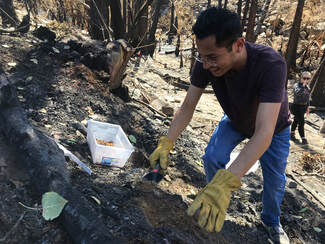 My name is Rey Becerra and I am an undergraduate civil engineering student at San Diego State University. I joined the Disturbance Hydrology Lab (DHL) during the spring semester, 2019. My research focuses on examining the post-fire sediment response in a riparian watershed with dense invasive plant species to better understand soil dynamics during the 2018-2019 storm season by developing a regression model to estimate soil erosion in relation to sediment physical characteristics after the storm events. 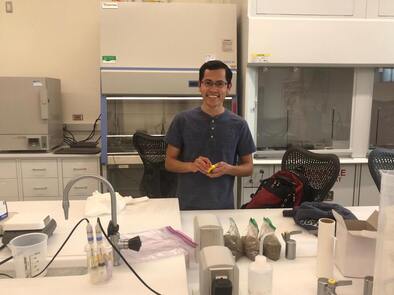 This research opportunity has allowed me to develop and apply new skills in different settings. Specific field tasks such as soil sample collection and surveying were existing skills I applied constantly and used effectively to obtain critical data for the understanding of soil dynamics. Lab skills I learned included performing methods to identify soil samples' physical characteristics and helped me to better understand topics discussed in my major This research project challenged my ability to communicate my data analysis in an academic research setting. However, by conducting presentations at several conferences and reporting my findings through a research report this experience offered me multiple opportunities to improve my communication skills. Additionally, this internship has given me a sense of belonging in the research team which I believe is important for any undergraduate student. Therefore, my involvement in the Disturbance Hydrology Lab has been beneficial for my academic growth inside and outside of class and it has granted me future prospects including pursuing a master’s degree in civil engineering with the objective to increase my career path opportunities in water resources engineering. The multiple field expeditions were my favorite experiences while being part of the Disturbance Hydrology Lab because they represented a challenge to a problem and as an undergraduate civil engineer it’s empirical to realize that applied sciences require creativity and critical thinking to approach the problem. 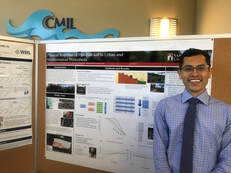 The research experience offered by the Disturbance Hydrology Lab is fundamental for STEM related majors seeking research opportunities to advance their understanding in water resources and hydrology. The DHL’s motivation to better understand hydrologic disturbances is significant for the developing urban communities and the experiences and opportunities offered to undergraduate students can be academically rewarding.
2 Comments
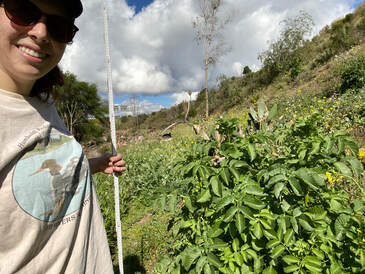 My name is Madeline Hapgood, I am an undergrad recently graduated from San Diego Mesa College, transferring to San Diego State University this fall. I had been studying geography and was excited when an opportunity to get experience in the field came up. After living in California and being so exposed to the damages wildfires can have upon a community made this experience even more meaningful to be a part of. When hearing about the projects being done on and around Alvarado Creek it was inspiring to hear what can and has been doane in the “backyard” of SDSU. Since this was my first time working in the field and doing research my knowledge of fieldwork and their processes were little to none. Overtime with every new fieldwork technique I learned I expanded my knowledge and passion for working in the environment. My project was based around the regrowth of the plant life from the burned area that had caught fire a month previous. In the beginning I was unsure what to expect and where to go from that point, where would I focus my research, how would I collect my research. With the help of mentors and volunteers I was able to go out and get help from others and learn other tools along the way. Not only did my project involve going out in the field and surveying vegetation heights and ground cover but I also got to use tools such as densiometers to calculate canopy cover. My project used a public photo point where the community was invited to share live photos of the site which would be shared to a public document. This was extremely helpful to have a visual timeline of the growth of plants throughout the time researching. Not only was this helpful for me as the researcher because I was not able to be there at the site all the time but also so the community could be involved and see the growth overtime as well they were welcomed to ask questions on the document as well. 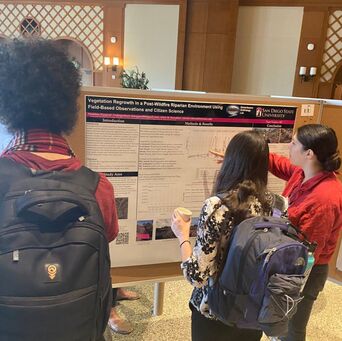 Although I was new to working in the field other skills and traits I had already helped me along the way. My creativity was one thing that I wouldn’t have expected to help throughout the research, research seems it would be rigid and strict but the opportunities and ideas can be endless. New skills I learned were learning how to learn again and accepting you may need to try and fail again. As well as to not expect an outcome to be one way or the other. The tools and research in the field were all new to me and were easy to learn along the way. Working in the field taught me that you can always learn new things and that it doesn’t all come naturally. This opportunity also taught me to believe in myself as well as thinking on your feet and diving into your research to see what can benefit you. I never considered myself a scholar or researcher but I never thought was possible especially as an undergrad. I had never planned on going to graduate school or getting a doctorate because I did not believe I could do it. This community and research opportunities showed me that I can do whatever I want and not let the unknowns keep me away. Talking with other researchers and getting experience at something I am passionate about made the experience meaningful. Being more detailed and planned would be a skill that would be important to have in this field especially when going out on the field with a partner. |
About the authorsFollow the adventures and reflections from the DHL undergraduate student interns and research assistants! Archives
June 2022
Categories
All
|
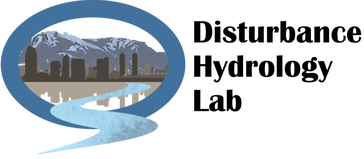
 RSS Feed
RSS Feed
